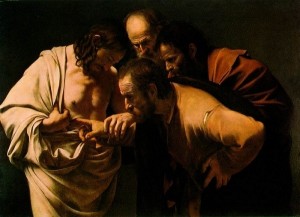 For the past few months, the image followed me. At work, I shuddered as I came across it in one of our study workbooks. This week again at a TOB seminar, there it was in its full, blazing glory: Caravaggio’s depiction of “Doubting Thomas” sticking his probing finger into the glorified wound of the Risen Christ.
For the past few months, the image followed me. At work, I shuddered as I came across it in one of our study workbooks. This week again at a TOB seminar, there it was in its full, blazing glory: Caravaggio’s depiction of “Doubting Thomas” sticking his probing finger into the glorified wound of the Risen Christ.
For me, it depicted a moment of holy intimacy, no more appropriate for public consumption than a marriage bed: Thomas’ hand guided to probe the gaping hole in the side of his loving, forgiving Lord. The same Lord who had forgiven them all for deserting him, even for denying their association – three times, before the cock crowed. Faced with the horror of the crucifixion, most ran and hid – all but the women, and the “beloved disciple.”
And then, the miracle: He was alive, after all. And they, too, had survived the ordeal … albeit a bit more shame-faced, for having fallen short. For having refused in the moment to follow, to “Come and see.”
This week, as I mentioned, I’ve been holed up at Black Rock Retreat Center, taking a TOB Intensive Course by Christopher West and hearing of the central mystery of the human experience: of God’s image imprinted upon our very bodies, male and female, and of our singular privilege of entering into that divine life of loving, holy communion.
We are also hearing about the effects of sin, how it obscures God’s image both in our physical bodies and in our human interactions. Between sessions I found myself chatting with a spiritual director from another part of the country, who listened to me unload about my home situation, and offered this bit of counsel: As women, we are designed to nurture, to remain open to cultivating intimate, protected relationships. We were not designed to be fighters – but when called upon to fight, we step up to defend and protect. We do it . . . but at a cost. If we are married, we need to be able to turn to our husbands for that place of comfort and safety. And when that isn’t possible, we need to have another place to receive that comfort in order to be able to have the strength to nurture, open and receptive, again.
In this week’s first reading, from the Book of Wisdom, we read about the “cost” of wisdom.
Beyond health and comeliness I loved her,
and I chose to have her rather than the light,
because the splendor of her never yields to sleep.
This kind of hard-won wisdom is more rare and precious than the most beautiful pearl or gemstone, more valuable than silver or gold. Indeed it costs something infinitely more valuable: Our very selves, poured out in sleepless nights and tireless days.
It is a warrior’s wisdom, the wisdom of the one who stands, and does not run away.
No wonder “Wisdom” is . . . portrayed as a woman.



